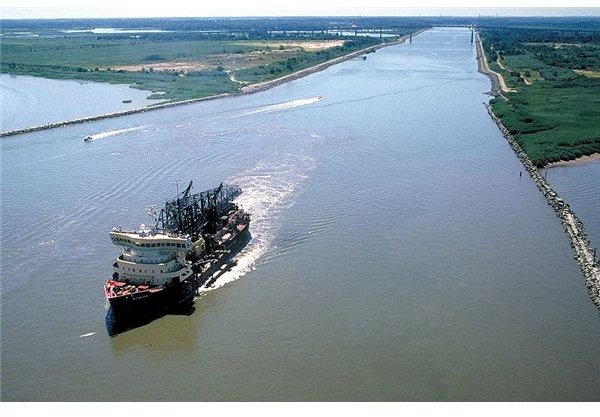Considerations for Entrance Training of Waterways
Position Entrances Correctly With the Proper Geometry
Waterways that discharge into large bodies of water like the sea or lakes need to be trained to discharge into them in such a way that the inflow is controlled in all kinds of conditions. This ensures that they will remain where they are and will not shift as untrained entrances do. Shifting of entrances can cause land conditions to change and can affect other structures on coastal land, thus leading to damage to property. So if the entrance training is done keeping various factors in mind, this will lead to stability.
Image Source: Wikimedia
Such entrances need to have a definite geometry even if there are no permanent structures like training walls or revetments. Bends and canals that meander may be less suitable and pockets that allow water to remain stagnant have to be avoided. Provision needs to be made for tidal waters and their effects on the entrance. Multiple entrances may be considered as these encourage flow through currents. Local circulation can be further enhanced by the provision of artificial islands or other elements that add roughness to the water flow. Sand bypassing using fixed dredges may require to be used to keep navigations channels open at entrances where there is lot of littoral drift.
Depths, Widths, Cross Sections, and Lengths of Entrances
Depth of the entrance canal must not be more than the depth of the waterway at the point of confluence. These depths must be enough for any craft that may use the waterway entrance to navigate from the waterway to the larger body of water or vice versa. The depths must be graded towards the entrance so that there is a constant flow of water and no stagnation. Depths must be sufficient to cater for high tides and other expected heights of the water. Provision must be kept for sedimentation that can occur and cause obstruction to the free flow of the water.
Width of the entrance must be sufficient to cater for the expected volume of water and also enough for maneuvering of craft that may use the entrance of the waterway and allow for two way operation of the maximum size of the boats that may use the waterway. Navigable width that is lesser than 20 meters should be avoided at all costs, unless the waterway is of a very minor nature.
The cross section of the entrance must be such that it takes into account the type of soil conditions, the likely fluctuation in water levels and any other situations that can affect the stability of side slopes. Any revetment walls must be situated well above the expected maximum water level so that they are never affected by water. These walls must also allow for erosion and their foundations should be deep enough to avoid such erosion. No development should be permitted within a minimum distance as specified by local building laws. Where available space is a problem, the engineer may have to consider training walls so that the entrance training is confined within a built up section that has been properly designed to take care of the most extreme of expected situations in water flow and other factors.
The length of the entrance canal has to take into consideration the stability of the banks and beds which may be affected by tide, wind, or wave action in the larger body of water. It should also be of sufficient length to ensure that the velocity of the water flow is maintained by the given slopes and to allow the section to be flushed so that there is no sedimentation that can affect the bed or cross section of the entrance canal. Water quality is another factor that has to be taken for deciding the length of the entrance canal.
References
Hydrodynamic alteration of coastal waterways
